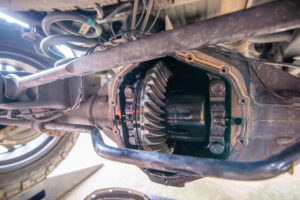Study Shows That Most Midsize SUVs Fail at Protecting Rear Passengers

According to a new study conducted by the Insurance Institute for Highway Safety (IIHS), most new midsize SUVs offer solid protection for the driver during a collision, while only a handful of the same models provided the same amount of safety to a passenger in the rear seat that was designed to replicate the physiology of a 12-year-old child, or a small woman.
Which New Midsize SUVs Passed?
In its newly updated crash tests, the IIHS captured collision data on thirteen mid-size SUVs that included a dummy in the driver’s seat, and another in the rear passenger seat. Every vehicle received a “good” safety rating for the driver. But for the passenger, only four of the thirteen models earned the same grade, which included the Ford Explorer, Ford Mustang Mach-e, Subaru Ascent, and Tesla Model Y.
RELATED: Crash Test Reminds Rear Passengers Why They Need To Belt-Up Before Going Airborne
Whicch New Midsize SUVs Failed?
The Chevrolet Traverse, Toyota Highlander, and Volkswagen Atlas trailed behind with a safety rating of “marginal.” Meanwhile, the Honda Pilot, Hyundai Palisade, Jeep Grand Cherokee, Jeep Wrangler 4-door, Mazda CX-9, and Nissan Murano received “poor” safety ratings for the rear passenger.
Why Did Midsize SUVs Need a New Safety Test?
This is part of the updated safety standard tests the IIHS has added for 2023, encouraging automakers to also raise their own safety standards for consumers. Because for vehicles produced from 2007 and up, the potential for a passenger in the rear seat to sustain fatal injuries during a collision is 46% greater than a belted driver and passenger in the front. This is mainly due to improved seatbelt technology has only been implemented for the front end of the vehicle’s interior.
RELATED: IIHS Raises The Standards for its 2023 Top Safety Pick Awards; Announces The Winners
In order for a vehicle to receive a good safety rating for the rear passenger, the sensors attached to the dummy must not reach certain levels that would suggest a serious injury to the head, neck, chest, abdomen, or thigh. Video replay of the tests also track the greasepaint painted on the dummy’s head in order to determine if the their seatbelt was effective enough to prevent the head from coming in contact with any part of the vehicle’s interior. They also were on the look for any signs of “submarining”, which is when the passenger’s body slides forward underneath their seatbelt after impact.
“Zeroing in on weaknesses in rear seat safety is an opportunity to make big gains in a short time, since solutions that are already proven to work in the front can successfully be adapted for the rear,” says IIHS Senior Research Engineer Marcy Edwards. “The four good ratings in this round of testing show that some automakers are already doing it.”









